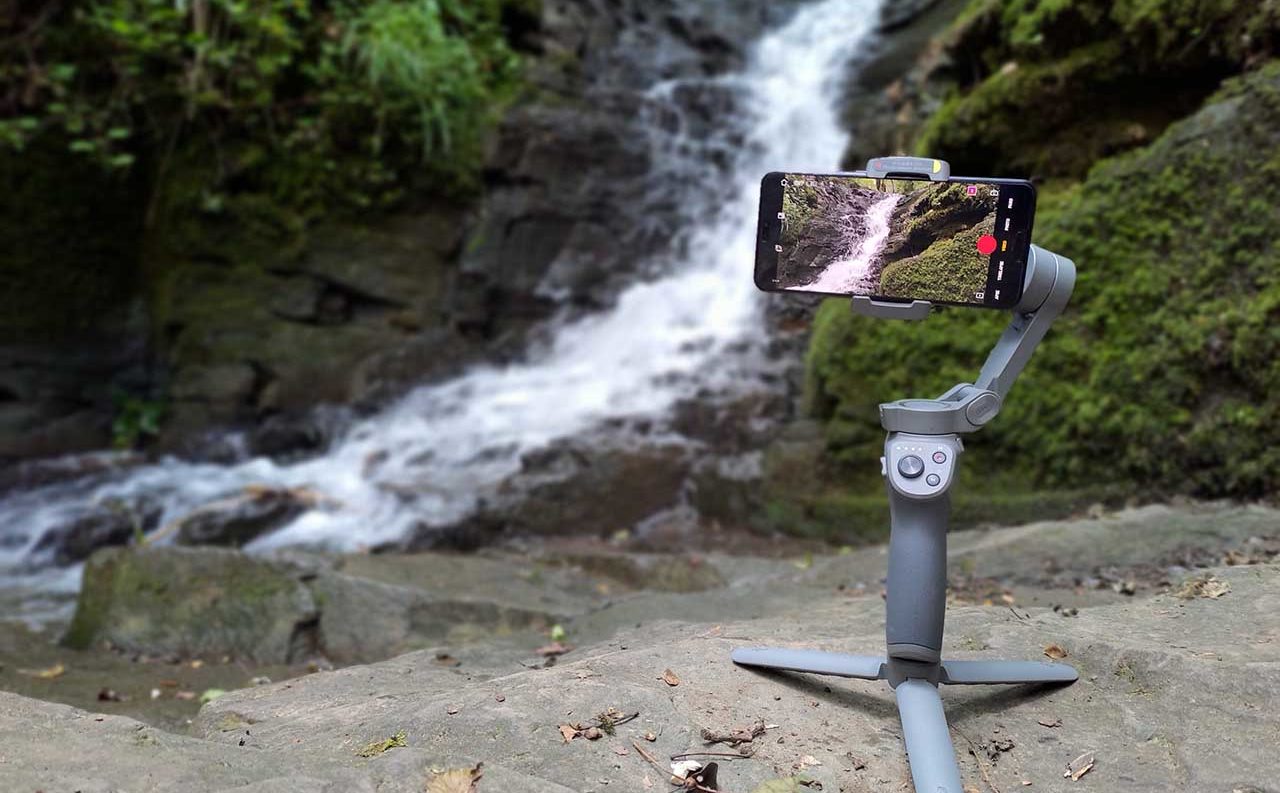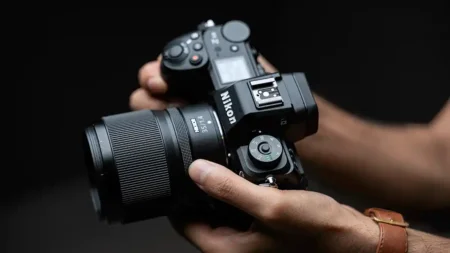What is the DJI Osmo Mobile 3?
The DJI Osmo Mobile 3 is the company’s latest motorised gimbal stabilizer for smartphones. New features include a folding design, USB-C charging, phone port access and a trigger control on the front of the handle.
The DJI Osmo Mobile 3 price tag is £99 / $100, the same prices as its predecessor, the Osmo Mobile 2.
You can buy the DJI Osmo Mobile 3 at Adorama and B&H Photo Video in the US or at Wex Photo Video and Park Cameras in the UK.
Features
What’s interesting about the Osmo Mobil 3 is that despite a slew of new features, DJI has kept its price tag the same as the Osmo Mobile 2 it replaces. So what’s new in the Osmo Mobile 3?
First and foremost is a new foldable design that requires no locking mechanism. The Osmo Mobile 3’s controls have also been redesigned along the handle so that users can control the gimbal’s movement or switch settings with just one hand.
Options such as Quick Roll rotates your phone’s orientation from portrait to landscape without having to remove your phone from the gimbal. You can do this by pressing the Mode (M) button twice.
You can also now use the trigger to lock the Osmo Mobile 3’s orientation, rotate it for selfies or re-centre the phone when tracking a subject. For the latter, tapping the trigger once activates ActiveTrack and the Osmo Mobile 3 will begin tracking your subject, keeping it centred in the frame.
A new zoom slider on the side of the Osmo Mobile 3 lets you customise zoom speed and avoid having to zoom via your phone’s touchscreen.
Other options include a Gesture Control mode via your phone’s selfie camera, which activates a self-timer and a Sport mode for panning in fast-moving scenes.
Story mode does all the work for your and automatically generates a short, edited video with a music soundtrack.
ActiveTrack 3.0 uses DJI’s AI algorithms to recognise and follow subjects of your choice. You’ll also find Panorama, Slow Motion, HyperLapse, TimeLapse and MotionLapse modes.
Build Quality
Let’s begin by talking about that new folding design. What’s great here is that, while it’s foldable, it’s also really simple to extend. Some gimbals I’ve used have folding designs, but to get it extended requires a complex system of latches and twists and turns.
With the Osmo Mobile 3, simply pull the gimbal arm upward and you’re ready to go.
Your phone sits in a tension tray that you pull open. This is a lot simpler to use than the Osmo Mobile’s old screw-on mount. And the cradle can support all of the biggest smartphones on the market without pressing the buttons on the side of your handset.
DJI has also tweaked the angle of the gimbal, tilting it slightly forward to make it more comfortable to hand hold over long periods. And in my tests, this certainly was the case.
The handle also gets a new rubberised grip. The body again is plastic, but it feels firm.
Another nice design touch is the addition of a USB port via which you can charge your phone, or other devices if you wish. Next to this on the side is a new USB-C port that charges the Osmo Mobile 3’s internal battery. DJI says it gets about 15 hours of use per charge, and I found this to be pretty accurate.
The button layout on the base of the gimbalis pretty minimalist. There’s an M button that doubles as a power button and a mode selector. You can also press this swap between portrait and landscape format orientations while filming.
Above that is a record button, and to the side are battery level indicators and a wheel for moving the phone left, right or up and down.
On the other side of the handle is a zoom toggle. On the front, underneath where your fingers rest, is a trigger control. This actually appeared in the first Osmo Mobile, disappeared in the Osmo Mobile 2, and makes its reappearance here.
Overall, the Osmo Mobile 3 design is very impressive and presents the best design of the Osmo Mobile series to date.
Performance
Let me just say, I can’t get over how easy this gimbal is to use. Because I own the Osmo Pocket, I already have the Mimo app on my phone. When powered on and the app loaded on my phone, the Mimo app instantly picked up the presence of the Mobile 3 and added a new Osmo Mobile tab at the top of the app. From there, I tapped a Connect button and that was it. Sorted.
I mentioned earlier the foldable design and how simple it is to extend: pull up on the arm and you’re ready to go. What’s nice is that you can also fold it up with your phone inside the cradle. This meant I could save time having to load and unload my Huawei phone each time.
Once powered on, just double-tap the M button to swap between portrait and landscape orientation.
So how stable is the Osmo Mobile 3? Flawless. In most situations, I found no wobble whatsoever. Whereas other units I’ve used will pick up, even slightly, the bob of your footsteps, the Osmo Mobile 3’s stabilisation system keeps it fluid.
Even running down a hill, chasing my children, the footage is remarkably stable. Maybe there’s the odd slight bounce, but on the whole I was quite impressed.
Tracking subjects like my kids running down the hill is also incredibly easy. Within the Mimo app just use your finger to drag a box over your focal point and then release. This sets the tracking in motion, and I found it very responsive and accurate. Only when my kids got too far ahead and were thus too small in the frame did the tracking lose them.
When tracking started to drift as I moved down the hill at a different pace to my kids, double-pressing the trigger re-centred the gimbal and everything was fine.
On other smartphone gimbals in this price bracket this might be enough, but DJI crams the features into the Osmo Mobile 3. Sport mode, for instance, lets you pan quickly while staying locked on your subject.
My kids also enjoyed using its gesture control for selfies. But if you were a vlogger (which they aspire to be), you can trigger the selfie camera to track you as you play Minecraft or do weird challenges – whatever it is kids do on YouTube these days.
When you’re done filming? Tap the M button three times and the phone cradle spins around, ready to be folded back into its travel position.
It’s so easy and convenient.
Verdict
It’s hard to think of a negative to say about the DJI Osmo Mobile 3. With its features, build quality and low price tag, I’m struggling to think of what could beat it.
The Moza Mini-S 3-axis smartphone gimbal stabiliser is probably the closest competitor and comes in at about £10/$10 cheaper, but I would give the edge to the Osmo Mobile 3. The Osmo Mobile 3’s folding design is much simpler and it has the edge on overall ease of use. I found the Mini-S menus and controls quite complex to navigate.
When I’m filming with my smartphone I want it to be quick and easy, and that is what the Osmo Mobile 3 brings to the table. And its stabilisation system is rock steady.
It’s worth noting the Benro 3XS here. It was launched a few weeks ago at the beginning of August 2019, and we’ve not had a chance to review it yet. But at roughly £10/$10 cheaper than the Osmo Mobile 3 it also promises 3-axis stabilisation in a folding design, with a built-in 3.5mm microphone port and a battery promising 24 hours operation on a single charge.
It sounds like it could be a contender, and the 3.5mm mic port could be the deal-breaker. But the other selling point for the Osmo Mobile 3 is that DJI’s Osmo brand isn’t going anywhere. The company continues to develop its Osmo ecosystem and is regularly pumping out accessories to make the filmmaking experience even better. All those things combined, I would buy the DJI Osmo Mobile 3 in a heartbeat or faster.



